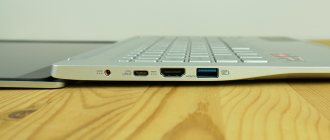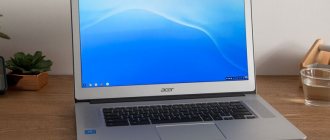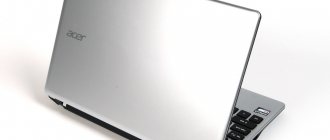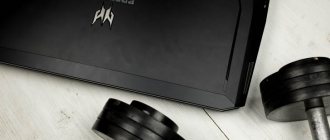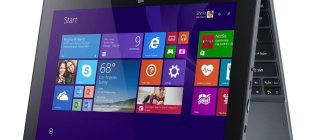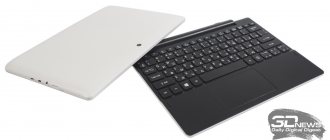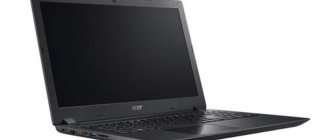Acer presented an updated line of ultra-light Swift 5 laptops back at IFA 2020, and they recently reached stores. And in a large number of different configurations. Among the main innovations, it is worth noting the fresh Intel Core processors of the Ice Lake-U family inside and a slightly updated design. Although the main feature remains the same: the weight of the Acer Swift 5 does not exceed 1 kg, which makes it an excellent travel companion.
Acer Swift 5 SF514-54T (NX.HHUEU.00C) Laptops, ultrabooks on
from 34,599 UAH
Suggestions: 16
Compare prices
⇡#Technical characteristics, equipment and software
You will find several versions of Swift 5 on sale. As you know, all markers have different tastes and colors, and therefore a potential buyer can choose from models in blue, black, gold and white. Also on sale you will still find models based on dual-core Kaby Lake processors of the previous generation, but the table below lists only the most modern components used in various modifications of Swift 5.
| Acer Swift 5 | |
| Display | 14", 1920 × 1080, IPS, touch |
| CPU | Intel Core i5-8250U, 4/8 cores/threads, 1.6 (3.4) GHz, 15 W |
| Intel Core i7-8550U, 4/8 cores/threads, 1.8 (4.0) GHz, 15 W | |
| Graphic arts | Intel HD Graphics 620 |
| RAM | 8 or 16 GB DDR3 |
| SSD: 256/512 GB | |
| Wireless module | Intel Wireless-AC 7265, IEEE 802.11b/g/n/ac, 2.4 and 5 GHz, up to 867 Mbps, Bluetooth 4.2 |
| Interfaces | 2 × USB 3.0 Type-A 1 × USB 3.0 Type-C 1 × HDMI 1 × 3.5 mm mini-jack acoustics/microphone |
| Built-in battery | 2 cells, 36 Wh |
| External power supply | 45 W |
| Dimensions | 329 × 228 × 14.9 mm |
| Weight | 0.97 kg |
| operating system | Windows 10 x64 Home |
| Guarantee | 1 year |
| Price in Russia according to Yandex.Market | 100,000 rub. per test model |
The Acer Swift 5 SF514-52T-88W1 model arrived for testing. It has a 512 GB SSD installed and 16 GB of LPDDR3 RAM. If you believe our computer stores, then you are getting acquainted with the most advanced version of Swift 5, for which they are asking an average of 100,000 rubles. At the same time, for 76,000 rubles you can purchase the SF514-52T-53MB model with Core i5-8250U, 8 GB of RAM and 256 GB SSD. For example, the HP Specter 13-af006ur model with identical characteristics costs an average of 91,000 rubles. Agree, the difference is noticeable.
We've sorted out the pricing policy. All Swift 5 are equipped with the Intel Wireless-AC 7265 wireless module, which supports IEEE 802.11b/g/n/ac standards with a frequency of 2.4 and 5 GHz and a maximum throughput of up to 867 Mbps and Bluetooth 4.2.
The laptop comes with a tiny power supply with a power of 45 W and weighing only 150 g. Finally, at least someone has thought of equipping lightweight devices with lightweight accessories!
Acer Swift 5: Performance
In our review, the Acer Swift 5 came with a quad-core Intel Core i5-8265U processor clocked at 1.6 GHz. Combined with 8GB DDR4 memory and 256GB PCIe SSD memory.
Acer Swift 5 test results
Here's how the Acer Swift 5 performed in our review tests:
- 3DMark: Sky Diver: 4547 | Fire Strike: 983 | Time Spy: 482;
- Cinebench (CPU): 545 points | Graphics: 53 FPS;
- GeekBench: 4657 ( Single Core ) | 14587 ( Multi-core );
- PCMark 8 (Home Test) : 3543 points;
- PCMark 8 (Battery Test) : 4 hours 31 minutes;
- Battery life (video test) : 7 hours 4 minutes;
While performance-intensive tests expose the weaknesses of a low-power processor like this one against Intel H-Series processors of the same generation, the laptop can be said to handle the workload it's designed for.
We spend a lot of time surfing the web, writing articles and editing content. For all these tasks, the Core i5-8265U is sufficient. Chrome launches in an instant and web pages load quickly, thanks to 802.11ac wireless connectivity with potential gigabit speeds that can harness the full potential of your home network connection.
The only problem that we noticed every now and then was the periodic lack of RAM. We can easily open over 20 tabs in Chrome, which will put more strain on the available 8GB of RAM. We kept switching to tabs that required a reboot. It's also a shame that a Core i5 is sufficient, but the only way to get more RAM is to upgrade to a Core i7 and pay significantly more for that upgrade.
Despite the lack of RAM, the Acer Swift 5 runs great. Even the speakers sound decent. The sound is directed from below and, despite this, the speakers sound quite clear. At maximum volume we didn't notice any distortion. These speakers aren't going to fill the room, but they are loud enough to listen to music in a quiet environment. The bass is weak and almost unnoticeable, of course.
⇡#Appearance and input devices
In general terms, the appearance of the Swift 5 can be described as simple. There are no pretentious or provocative elements in the design of the laptop. But is this really important, because this is just a workhorse. It may seem that the body of the device is entirely made of matte plastic, but this is not the case. A special magnesium-lithium alloy is used, which, according to the manufacturer, increases the ductility of the material without loss of strength.
I would rate the build quality as excellent; there is no evidence of slack in the work. And the blue plastic turned out to be surprisingly practical - neither fingerprints nor dust are visible on it.
Yes, the Swift 5 doesn't break any records, but at 14.9mm thick, the device can still be called thin. Much more important is that the ultrabook weighs only 970 grams, so you can easily take it with you anytime, anywhere. Even with an external power supply in the backpack, such a burden is practically not felt.
The Swift 5 uses a 14-inch display, but if you compare the case sizes, the tested model turns out to be slightly larger than ultrabooks such as the HP Specter 13 and Acer Swift 7.
The laptop lid opens 180 degrees. There are no complaints about the hinges - they position the screen quite accurately and do not allow it to dangle while typing. At the same time, it is impossible to open the lid with one hand.
It’s okay that the Swift 5 doesn’t compete with other models for the title of the thinnest ultrabook, because this made it possible to retain full-fledged connectors among the interfaces. So, on the left side of the laptop there is only a 3.5 mm jack for connecting a headset. There are also laptop activity indicators and a slot for a Kensington lock. On the right side there is a port for connecting a power supply, an HDMI output, a pair of USB 3.0 A-type and one USB 3.0 C-type.
There are no connectors on the front or back. The air is drawn in by the fan through a fine grille located on the bottom of the laptop and blown out through the perforations on the back wall.
The keyboard is somewhat reminiscent of the one used in older Acer models, such as the Aspire R13. The flat keys, measuring 16 x 14 mm, are low in height and spaced 3 mm apart. Typing text on such a keyboard is quite convenient, since all the buttons are located in their places. But the Esc, Prt Sc, Del keys and the F1-F12 series turned out to be small, so you will have to get used to working with them. The Swift 5 keyboard also has inconvenient arrow buttons, which simultaneously have functions for decreasing/increasing sound and screen brightness.
The keyboard backlight has only one color and one brightness level, which personally suits me quite well. By default, the F1-F12 range works, which is actually somewhat atypical for ultrabooks, since multimedia functions are usually considered a priority. However, this suits me too.
There are no complaints about the touch panel: it is not as large as in Swift 7, but it performs its function well. The surface of the touchpad is pleasant to the touch, gestures are recognized normally, and pressing is accompanied by a distinct and fairly loud click. The touchpad behaves quite adequately in operation - tested in the computer card game Gwent.
As for the webcam, the Swift 5 uses a standard matrix with a resolution of 720p and the ability to record at 30 Hz - with all the ensuing consequences. Thus, it is possible to obtain a satisfactory picture quality only in bright sunny weather. Indoors, under artificial lighting, the image is very noisy. For Skype calls this quality will be quite enough, but for something more serious - definitely not.
Acer Swift 5: Design and display
The 15-inch Acer Swift 5 looks stylish most of the time, but there are a few areas where its budget roots show.
The body is primarily made of metal, a combination of magnesium-lithium and magnesium-aluminum alloys that maintain the weight of the laptop and give it a premium metallic look. However, this alloy does not feel as “metallic” to the touch as aluminum cases.
The chassis ultimately feels like hard plastic rather than metal. The area under the keyboard can sag under some pressure, and the thin display feels loose.
The trade-off is that it is a very light metal. The total weight of the Acer Swift 5 is less than 1 kilogram. There's nothing difficult about lifting a laptop by the corner of the chassis and then throwing it into your backpack without feeling the weight. The charger is barely larger than a smartphone and serves only to sum up the mobility of the Swift 5.
While most 15-inch laptops come with full-size keyboards, the stripped-down design of the Acer Swift 5 reduces the number of keys. The keyboard has a full backlight, but only a simple white one.
There is no way to change the light level, but the backlight illuminates all keys, no exceptions. Whether it's a letter, a number, a special function key or a secondary media control, it's backlit. However, the key lighting is inconsistent, with some areas of the keyboard looking a little dim, which is typical of low-profile membrane keyboards. We didn't notice any obvious errors, so we say the keyboard works well when typing, but there are no features that make us want to compare the keyboard with its competitors.
There's no reason to worry about the keyboard. The keys respond uniformly while typing, with slight resistance.
Below the keyboard is a thin fingerprint scanner that works with Windows Hello for biometric login, and the trackpad is quite simple and blends in with the laptop's body. It has a nice feel to it, but there is a noticeable quirk.
Placing one finger on it to click when moving the pointer, the other finger moves the pointer, but this combination actually results in a moving cursor. The lack of the so-called “Palm Rejection” feature can interfere with precise cursor positioning in certain places, such as on buttons or between letters when editing text. A small problem that will turn into hell if you do a lot of text work or are just trying to quickly close tabs without anyone noticing.
All ports of the Swift 5 are located on the sides. The power connector is on the left and moves around a bit, as if it doesn’t fit tightly enough. However, the charging cable connection remained reliable. On the left side there are two USB 3.0 Type-A ports and one Type-C USB 3.1 Gen 2 port. There is also a full-size HDMI port on the side, but it cannot work with 1440p monitors with frequencies above 60 Hz.
On the right side there is a lock slot and a headphone jack. There's a catch here, because the headphone jack is located on the right side of the computer, which may not seem like a big deal until you find out how many headphones run a cable from the left earbud. For short wires this is a serious problem.
The screen is the standout part of the Acer Swift 5. It measures 15.6 inches diagonally, even though the body of the computer is smaller and the bezels are quite thin. The display is a Full HD (1920 x 1080) IPS panel with a simple 16:9 aspect ratio. With a peak brightness of 300 nits, it is blindingly bright, even on a sunny porch it was possible to make out the image without any problems. Yes, the picture is not the clearest in direct sunlight, but the display is usable. With 100% coverage of the sRGB color space, the panel can accurately reflect colors for web design purposes.
The bezel around the screen is made of rubberized plastic, which is one of Acer's cut corners in its quest for budget pricing, but it shouldn't put you off thanks to the screen's brightness and thin 5.87mm bezels.
We enabled high dynamic range (HDR) in Windows settings, and while we enjoyed impressive visuals across much of the content, it was difficult to tell how authentic the HDR was. For example, Guardians of the Galaxy looks amazing on this screen, but there doesn't seem to be any HDR encoding.
Meanwhile, streaming Star Wars: The Last Jedi, we see obvious color streaks between the red hues in Kylo Ren and Rey's epic lightsaber battle. The same goes for dark backgrounds. This could very well be a Netflix encoding bug, but Acer's panel settings and Windows HDR don't implement any magic tricks.
However, the screen copes flawlessly in entertainment and work. The hinge is also quite durable, making the touchscreen easier to use.
⇡#Internal structure and upgrade options
The laptop is very easy to disassemble, however, the design of the device uses screws with Torx slots (popularly called an asterisk). After removing the 11 screws, all that remains is to carefully remove the bottom.
As is often the case with Ultrabooks, most of the internal space is occupied by the battery. The Swift 5 uses two 4670 mAh cells with a rather unusual voltage of 7.7 V. A small cooling system consisting of a single heat pipe, a tiny aluminum radiator and a tangential fan is responsible for dissipating heat from the Core i7-8500U.
16 GB of RAM are soldered directly to the motherboard. It’s no longer possible to somehow increase the RAM capacity, and that’s why it’s better to immediately buy a model with 16 GB. The system uses DDR3-2133 RAM.
It only makes sense to disassemble the laptop yourself if you want to replace the SSD over time. In the test model, a Micron 1100 MTFDDAV512TBN with a capacity of 512 GB is installed in one of the two M.2 connectors. This SSD operates in SATA 6Gb/s mode, although the Swift 5 motherboard supports PCI Express devices. I consider the presence of a second port for installing another 2280 form factor drive to be an undeniable advantage of this device.
⇡#Testing methodology
Since the laptop uses a built-in video card, there is no point in testing the device in modern AAA projects. And it’s clear that HD Graphics 620 won’t work. Nevertheless, on the Acer Swift 5, just like on the Specter 13, we ran the following games in Full HD resolution:
- World of Tanks EnCore . Built-in benchmark. Minimum quality. No smoothing.
- Dota 2 . Recording the match. Low quality. No smoothing. DirectX 9.
- “Gwent. The Witcher. Card game" . Party with a computer. High quality. No smoothing.
- Counter-Strike: Global Offensive . Map "Mirage" with bots. Low quality. No smoothing.
Gaming performance was determined using the well-known FRAPS program. With its help, we get the rendering time of each frame. Then, using the FRAFS Bench Viewer utility, not only the average FPS is calculated, but also the 99th percentile. The use of the 99th percentile instead of the minimum number of frames per second indicators is due to the desire to clear the results from random performance spikes that were provoked by reasons not directly related to the operation of the main components of the platform.
Processor and memory performance were measured using the following software:
- Corona 1.3 . Testing rendering speed using the renderer of the same name. The speed of building a standard BTR scene used to measure performance is measured.
- WinRAR 5.40 . Archiving an 11 GB folder with various data in RAR5 format and with the maximum degree of compression.
- Blender 2.79 . Determining the final rendering speed in one of the popular free 3D graphics packages. The duration of building the final model from Blender Cycles Benchmark rev4 is measured.
- x265 HD Benchmark . Testing the speed of video transcoding into the promising H.265/HEVC format.
- CINEBENCH R15 . Measuring the performance of photorealistic 3D rendering in the CINEMA 4D animation package, CPU test.
Display testing was done using the X-Rite i1Display Pro colorimeter and the HCFR app.
The laptop's battery life was tested in three modes. The first load option - web surfing - involves alternately opening and closing tabs on the sites 3DNews.ru, Computeruniverse.ru and Unsplash.com with an interval of 30 seconds. This test uses the Google Chrome browser with the "Block third-party data and cookies" and "Don't allow sites to store data" options enabled. In the second mode, x265 (HEVC) video is played in a standard Windows 10 player with the repeat function activated. The third type of load is running the Unigine Heaven benchmark at maximum graphics quality settings in full screen mode. In all three cases, the same display brightness was set at 180 cd/m2.
The following laptops perform in games and other applications:
| Test participants | ||||||
| Model | Screen | CPU | RAM | Graphic arts | Storage device | Battery |
| HP Specter 13-af008ur | 13.3", 1920 × 1080, IPS | Intel Core i7-8550U, 4/8 cores/threads, 1.8 (4.0) GHz, 15 W | 16 GB, DDR3-2133, two channels | HD 620 | SSD, 512 GB, PCI Express x4 2.0 | 4 cells, 43.7 Wh |
| ASUS FX570UD | 15.6", 3840 × 2160, IPS | Intel Core i7-8550U, 4/8 cores/threads, 1.8 (4.0) GHz, 15 W | 16 GB, DDR4-2400, two channels | NVIDIA GeForce GTX 1050, 4 GB GDDR5 | HDD, 500 GB, 5400 rpm + SSD, 256 GB, SATA 6 Gbit/s | 3 cells, 48 Wh |
| Acer Swift 5 | 14", 1920 × 1080, IPS | Intel Core i7-8550U, 4/8 cores/threads, 1.8 (4.0) GHz, 15 W | 16 GB, DDR3-1066, two channels | HD 620 | SSD, 512 GB, SATA 6 Gb/s | 2 cells, 36 Wh |
⇡#Display and sound
The Swift 5's screen bezels are no larger or smaller than other ultrabooks. Since we are dealing with a touch screen, its surface is glossy, with all the ensuing consequences: fingerprints, smudges, dust on the screen and glare. If you believe the official Acer website, then you can find a version of Swift 5 on sale without a touch layer, but with the same glossy finish.
In the case of our model, the AUO203D IPS matrix manufactured by AU Optronics is used - the same panels are found in the HP Pavilion 14 and Acer Aspire R14 models. The screen has a high contrast ratio for an IPS matrix - 1417:1, and the color temperature is around 7000 K. The gamma is somewhat high - 2.25 versus the standard 2.2. The minimum brightness is 14 cd/m2, the maximum is 238 cd/m2. Given the glossy finish, there are concerns that it will be difficult to work with the laptop, for example, outdoors on a bright sunny day.
Gamma | Color gamut | Colorful temperature |
The display is calibrated at an average level. The average gray scale deviation is 3.13 (maximum - 7.26). In the ColorChecker test using 24 color patterns, the average error was 3.52. For normal use, such matrix parameters are not critical, but I would not recommend Swift 5 to designers and artists.
As is the case with other IPS matrices, there is no escape from the Glow effect: it is clearly visible on a black field, but on color images you hardly notice it. If there is no PWM or its frequency is too high for the human eye to notice, the LED backlight used can be classified as a Flicker-Free solution throughout the entire operating range. The stated viewing angles - 178 degrees vertically and horizontally - are true.
Two speakers are located on the bottom of the laptop, closer to the user. The manufacturer claims to support the Dolby standard, but in fact the sound of the Swift 5 is inexpressive. The volume reserve of the acoustics is average, but at maximum, no wheezing or other artifacts were noticed. At the same time, the speakers clearly lack bass, so musical compositions sound very flat and... tasteless, or something.
Temperature, frequencies and noise
The quad-core Core i7-8550U has four physical cores and supports Hyper-Threading technology. The frequency of this chip varies over a wide range, but when all four cores are loaded it should be 3.7 GHz - this is how Turbo Boost technology works.
Using the HP Specter 13 and ASUS FX570UD laptops as an example, we found out that the Core i7-8550U will not work under load at this frequency. At the same time, the processor does not overheat, but in programs of the caliber of LinX it very quickly reaches the power limit. In Swift 5, this quad-core chip is seriously cut - after just a few seconds its frequency drops to 1.1 GHz. In this operating mode, the temperature of the hottest core reaches 68 degrees Celsius, and the noise level measured from a distance of ~30 cm is 39.9 dB. The laptop is audible, but its operation can be called quiet. I think Acer engineers deliberately sacrificed the performance of the chip for the sake of low heating, quiet operation and, looking ahead, long battery life.
Let's not forget that programs of the caliber of LinX and Prime95 place a very heavy load on the central processor and RAM. Regular applications that we use every day are not capable of this. And yet, the LinX baptism by fire test is carried out to determine what a laptop cooling system is capable of under the most critical conditions. For example, when encoding video, the frequency of the Core i7-8550U drops to 1.4 GHz - this is still below the nominal parameter of 1.8 GHz. At the same time, the processor temperature under load remains at the same level - 68 degrees Celsius.
The screenshots above show that in LinX the peak temperature of the chip was 82 degrees Celsius, and in x265 Benchmark it was 91 degrees Celsius. Such short-term temperature peaks are obviously associated with the inertia of the cooling system, since there is a short period of time between the load applied to the central processor and the start of active fan operation.
Processor, RAM and disk performance
It is also obvious that the Core i7-8550U, operating at lower frequencies, will be noticeably inferior to its counterparts, but at a normal frequency. However, the Swift 5 is seriously ahead of ultrabooks that have chips such as the Core M7-6Y75 and Core i7-7500U. For example, in the CINEBENCH R15 benchmark, the test model was 35% faster than the HP Elite X2 G1.
However, the Swift 5 is noticeably inferior to the recently tested Specter 13, whose Core i7-8550U operates at 2 GHz under the same conditions. Plus, the fact that the HP Ultrabook uses a faster NVMe drive has an impact.
| Intel Core i5-7300HQ (HP Omen 17) | Intel Core i7-8550U (HP Specter 13-af008ur) | Intel Core i7-8550U (ASUS FX570UD) | Intel Core i7-8550U (Acer Swift 5) | Decreased performance, % (relative to the HP Specter 13 model) | |
| Corona 1.3, with (less is better) | 452 | 450 | 323 | 611 | -26 |
| WinRAR 5.40, with (less is better) | 693 | 576 | 516 | 608 | -5 |
| Blender 2.76, with (less is better) | 493 | 367 | 289 | 545 | -33 |
| x265 HD Benchmark, FPS (more is better) | 12,2 | 9,7 | 11,3 | 6,7 | -45 |
| CINEBENCH R15, points (more is better) | 511 | 498 | 654 | 399 | -25 |
SSD performance
As we have already found out, the Swift 5 has a Micron 1100 MTFDDAV512TBN SSD, which operates in SATA 6 GB mode. For its class, this drive demonstrates a quite typical level of performance. A capacity of 512 GB (real - 476 GB) will be quite enough for an ultrabook, and if desired, you can install a second SSD in this model, which significantly simplifies the upgrade process.
Acer Swift 5 Ultrabook review: Thinner, lighter and still affordable
Not long ago we got acquainted with a new line of compact laptops from Acer - Swift 3, which marked a global update of the entire lineup of laptops from the Taiwanese giant. The Swift 5 series reviewed today is one step higher in the newly created hierarchy of laptops and offers its future owner even more mobility and even more compactness for a relatively small difference in price.
The laptop is made in the actively gaining popularity class of 14-inch devices and is equipped with everything necessary to perform a wide range of multimedia and office tasks throughout the working or school day. Depending on the configuration, Swift 5 can carry on board an Intel Core i5 or Intel Core i7 processor of the latest generation Kaby Lake, 4 or 8 gigabytes of RAM, a high-speed solid-state drive with a capacity of up to 512 gigabytes and a high-quality IPS matrix with a resolution of 1920x1080 pixels.
| Model | Acer Swift 5 (SF514-51-53TJ) |
| Products webpage | acer.com |
| CPU | Intel Corei5-7200U, 2500 MHz (up to 3100 MHz in Turbo Boost mode) |
| RAM | 4 GB, DDR3-1600 |
| Display | 14″, 1920×1080, glossy, IPS |
| Video card | Intel HD Graphics 620 |
| Disk subsystem | SSD 256 GB, Liteon CV3-8D256 (M.2, SATA 6 Gb/s) |
| I/O Ports | 2x USB 3.0, USB 3.1 Type-C, HDMI 1.4, Headphone-out jack |
| Communications | Integrated 802.11 a/b/g/n/ac, Bluetooth 4.0 |
| Card reader | SD (XC/HC) |
| Multimedia | Audio system 2.0, webcam |
| Battery | 4670 mAh |
| Power adapter | 45 W |
| Dimensions | 327 x 228 x 14.6 mm |
| Weight | 1.3 kg |
| Price | $850 |
We received the most affordable version of the device for testing, which can be purchased in Ukrainian stores for approximately $850. The set of technical characteristics offered in this model fully meets the needs of the modern user. At the same time, there is some concern about the presence of only four gigabytes of RAM, which, even if desired, cannot be expanded by installing an additional RAM strip. Whether or not this factor will affect the overall speed of daily operation of the system, we will consider in detail during the test part of the material.
Packaging and equipment
The laptop comes in a plain black cardboard box with a small amount of branding elements.
Inside, the review hero is securely packaged, there is a set of paper instructions and conditions for warranty repairs, as well as a 45 W power supply. The latter, due to its compact format, fits perfectly into even the smallest laptop bag.
Appearance
The overall appearance of the laptop is classic in style: the color scheme uses a combination of rich black and silver, all sharp edges are slightly rounded, and there are no colored lights or other trendy gaming design elements.
At the same time, Acer marketers tried to somehow distinguish their product from competitors and their solution was the embossed surface of the top cover of the laptop, which is clearly visible in the photo below. From a practical point of view, this step turned out to be somewhat controversial, since in this version the laptop begins to collect dust noticeably more actively and requires more careful care.
The dimensions of the laptop are 327x228x14.6 mm, with a total weight of 1.3 kg. Here, Acer engineers tried to fit the components into the body of the 13-inch model. The bottom edge has several perforated ventilation holes, which, given the small thickness of the laptop, should help with cooling its internal components. Four rubberized feet located along the edges of the case are responsible for the stability of the device on the working surface.
The build quality can be described as good, and taking into account the low price factor - excellent. All components fit without gaps, there are no backlashes. The top cover is subject to slight deflection when pressed, but for a thickness of 14 mm this is understandable. The laptop is pleasant to hold in your hands and a pleasure to work on.
The screen hinge used is highly rigid, so in most cases the user will have to use both hands to open the top cover of the laptop. The maximum display tilt angle is 135 degrees.
The set of available connection interfaces is complete and has not undergone restrictions in the pursuit of minimizing external dimensions. On the right side of the laptop there is an HDMI port, classic USB 3.0 and updated USB 3.1 Type-C.
On the left side there is another USB 3.0, a headphone output and a card reader for SD cards (XC/HC).
The webcam took its place on the top frame of the display bezel. The frames themselves are now noticeably thinner than in the previously reviewed Swift 3. Their thickness still does not reach the “limitless” design of the Dell XPS 13, but overall the laptop began to look more interesting and relevant.
The Acer Swift 5 uses a full-size island-style keyboard. Among its features, it is worth noting the combined left/right arrow keys and Pg Up/Home/Pg Down/End buttons. This can be a bit confusing at first and will take some getting used to. The keys themselves have a short, quiet and responsive stroke. After a short adaptation period, typing text in Swift 5 is easy and comfortable.
The keyboard is equipped with a two-level white backlight and is easy to read at night.
The large touchpad supports a number of gestures and touches provided by the Windows 10 operating system. I did not have any comments or complaints about its operation. It copes with its task quite well and does not hinder the owner’s workflow if for some reason he left the laptop mouse at home. There is a fingerprint scanner in the upper left part of the touchpad.
Screen
Unlike Swift 3, we have a Full HD matrix with a glossy surface finish. The unconditional advantage of such a screen is the complete absence of a crystalline effect, which will be important for users who work a lot with small text. A natural disadvantage is specularity, reflection of objects and glare when hit by direct rays of light.
A large reserve of brightness of the panel backlight, which can be adjusted in the range from 20 to 282 cd/m², helps to partially correct the situation with glare. The jump in backlight intensity from 191 cd/m² to 282 cd/m² when moving from 90% to 100% screen brightness in the laptop setup menu looks somewhat strange. Among the strengths of the matrix, it is also worth noting the consistently high static contrast ratio, which averaged 1394:1.
Analysis of the matrix using the X-Rite i1Display Pro calibrator showed that the factory settings are at an acceptable level for consumer laptops. The color gamut covers 89.6% of the sRGB color space and is 64.6% equivalent to the AdobeRGB standard. The color temperature throughout the entire brightness range is close to the reference value of 6500K. The gamma curves are located above the reference line, which indicates a slight decrease in the contrast of the output image.
The DeltaE deviation turned out to be significantly lower than one would expect: 0.48 units on average (normal up to 1.5) and 1.28 units at the peak (normal up to 4).
Viewing angles are close to a maximum of 178 degrees. When the viewing point is shifted, the picture remains bright, saturated and is not subject to color fading.
For those buyers who are interested in the guaranteed absence of PHI modulation on the screen, we want to confirm that the Swift 5 matrix does not have it, or the pulse frequency is at such a high level that the camera is not able to detect it. In any case, the user is free to choose any level of backlight brightness without fear of causing any harm to his eyes.
Internal organization
The laptop's performance is ensured by the energy-efficient Intel Core i5-7200U central processor. It belongs to the latest generation of Intel microarchitecture - Kaby Lake and is manufactured using a 14-nanometer process technology. Two physical cores, thanks to support for Turbo Boost technology, can increase the clock frequency from a base mark of 2500 MHz to 3100 MHz, and the presence of Hyper-Threading technology allows you to process four threads at once. Four gigabytes of DDR3-1600 RAM are soldered directly on the motherboard, so, as we mentioned at the beginning of the material, it is not possible to further increase the amount of RAM. The memory operates in dual-channel mode.
The system storage is SSD LiteOn CV3-8D256, with a capacity of 256 gigabytes. The disk is made in the M.2 2280 form factor, the data transfer interface is SATA 6 Gb/s.
Test results
| Model | Acer Swift 5 | Acer Swift 3 | Razer Blade Stealth UHD | Dell XPS 13 |
| CPU | Intel Core i5-7200U 2.5 GHz (3.1 GHz Turbo Boost, TDP 15 W, 2 cores, 4 threads) | Intel Core i7-6500U 2.5 GHz (3.1 GHz Turbo Boost, TDP 15 W, 2 cores, 4 threads) | Intel Corei7-6500U 2.5 GHz (3.1 GHz Turbo Boost, TDP 15 W, 2 cores, 4 threads) | Intel Core i7-5500U 2.4 GHz (3 GHz Turbo Boost, TDP 15 W, 2 cores, 4 threads) |
| RAM | 4 GB, DDR3-1600 | 8 GB, DDR4-2133 | 8 GB, LPDDR3-1866 | 8 GB, DDR3-1600 |
| Display | 14″, 1920×1080, IPS | 14″, 1920×1080, IPS | 12.5″, 3840×2160, IGZO | 13.3″, 3200×1800, IPS |
| Video card | Intel HD Graphics 620 | Intel HD Graphics 520 | Intel HD Graphics 520 | Intel HD Graphics 5500 |
| Disk subsystem | SSD Liteon CV3-8D256 (256 GB, M.2, SATA 6 Gb/s) | SSD Liteon CV3-8D512 (512 GB, M.2, SATA 6 Gb/s) | NVMe Samsung MZVLV256 (256 GB, M.2) | Samsung PM851 (256 GB, M.2) |
| Pre-installed OS | Windows 10 64-bit | Windows 10 64-bit | Windows 10 64-bit | Windows 8.1 64-bit |
In the test part of the review, we will compare the performance of Swift 5 with its younger brother Swift 3, although if you carefully analyze the table of technical characteristics, it turns out that the hero of the review will be the “junior” in this test, because in comparison with other test participants only in his The configuration has an Intel Core i5 central processor and only 4 gigabytes of RAM. Competitors from Dell, Razer and the same Acer have Intel Core i7 CPUs of previous generations and double the amount of RAM, often operating at a higher frequency.
Overall Performance
PCMark 8
In comprehensive PCMark 8 benchmarks, Swift 5 took second place, confidently beating the Razer Blade Stealth UHD and Dell XPS 13 and falling slightly short of the Acer Swift 3. Unlike desktop Intel CPUs, the technological differences between Core i5 and Core i7 mobile processors in the energy-efficient U -series are minimal and come down to a higher clock speed and an additional megabyte of third-level cache for models with the i7 index. Thus, in the mobile segment, updating the processor microarchitecture can have a significant impact on the final level of system performance, and this is precisely what explains the dominance of the Core i5-7200U over its more expensive predecessors of previous generations: Skylake and Broadwell.
Cinebench R11.5/R15
In the Cinebench tests, the hero of the review managed to improve his position - Swift 5 became a leader in two out of four subtests. The gap from its counterpart in the remaining test modes is measured at 2-17%.
x264 HD Benchmark
The recorded difference in video encoding performance between the Acer Swift 5, Acer Swift 3 and Razer Blade Stealth UHD was minimal. The nominal winner in this test was the Acer Swift 3 laptop, with an average handicap over its pursuers of 4%.
Adobe Photoshop CC 14
The Swift 5 ultrabook coped with a real series of photo processing tasks in the Adobe Photoshop graphic editor in 216 seconds, which is two times slower than the leader Razer Blade Stealth UHD. The difference in the amount of RAM between the test participants made itself felt, which once again reminds future owners of the need to be careful when choosing a specific PC configuration and take into account the types of load that they will have to face during the further daily use of their device.
AIDA Cache & Memory Benchmark
The Swift 5 RAM operates at a frequency of 1600 MHz with timings that are somewhat high for the DDR3 standard. The peak reading speed was 23424 MB/s, writing - 23707 MB/s, copying - 22813 MB/s.
Disk subsystem
CrystalDiskMark
The LiteOn CV3-8D256 solid-state drive used demonstrates good performance indicators for its size. Especially considering that the SATA 6 Gb/s interface is responsible for data transfer. The maximum linear read speed exceeded 552 MB/s, the write speed was recorded at 472 MB/s. Against the background of other results, the high speed of reading 4K blocks also stands out, which reached 33.57 MB/s.
PCMark 8 Storage
In real-world load scenarios simulated by the PCMark 8 Storage benchmark, the average SSD speed was 202.51 MB/s. The LiteOn CV3-8D256 turned out to be the fastest in the Adobe Photoshop subtests, Microsoft Office applications and Adobe InDesign.
Gaming applications
3DMark
The integrated Intel HD Graphics 620 video core received a performance increase of 10–20% compared to its predecessor, which guaranteed Swift 5 first place in all 3DMark tests. The final result of 902 points in the most demanding of them, Fire Strike, suggests that the available power reserve of the integrated graphics will be enough to play modern, undemanding games.
Games
For a comfortable fps level, of course, you will need to reduce the screen resolution to 1366x768 pixels and select the appropriate graphics settings for a specific gaming application. After this, in most popular gaming projects you can expect an average frame rate of 60 fps or higher.
Cooling system efficiency and noise level
The cooling system capabilities were tested in a room with a stable air temperature of 24 °C. Both the peak values of the internal components of the device and the heating level of its body were measured. The required load was provided by the AIDA64 utility.
The Acer Swift 5 cooling system consists of only one elongated radiator and one radial fan. Despite this, and also taking into account the compact dimensions of the ultrabook, the bundled CO copes well with the task assigned to it. During the stress test, the outer part of the working surface of the keyboard warmed up to a maximum of 40.5 ° C and the temperature continued to gradually decrease as it moved away from the location of the hottest components of the system. The central processor operated stably at a frequency of 2900 MHz at peak load, while the core temperature did not reach the 80 °C mark, which is a very good result. There is no throttling.
The downside to the high performance at low temperatures was the CO noise level, which can be described as above average. The launch of resource-intensive applications is accompanied by a systematic increase in the fan rotation speed, the hum of which will be clearly distinguishable. Everyday tasks such as surfing the Internet or watching HD videos are performed with minimal acoustic background from the operation of the CO.
Battery life
Testing of the laptop's battery life was carried out according to the updated methodology. We still used the Battery Eater Pro v2.70 utility and its three built-in benchmarks: maximum system load, read mode, and idle mode. The role of the source file when watching the video was taken over by the film Interstellar (.mkv format, bitrate 7698 KB/s). During all tests, the Wi-Fi module was activated. The difference is that now the screen brightness was not set as a percentage of the maximum, but was fixed at 120 cd/m².
The battery capacity of 4670 mAh will be more than enough to keep the laptop running throughout a standard working day. To be more precise, ten hours of video viewing and twelve and a half hours of reading are the best results among all laptops previously tested in our laboratory.
conclusions
The Acer Swift 5 ultrabook is a universal solution for performing a wide range of multimedia and office tasks. Thanks to its compact dimensions and light weight, as for a 14-inch device, it is perfect for daily use in the modern active world, when the user needs to regularly move around the city or travel beyond its aisles. Among the strengths of Swift 5, it is necessary to highlight a good level of performance and a high battery life. Despite our concerns, four gigabytes of RAM in the basic configuration of the laptop turned out to be quite enough to run most of the test applications, but if you are considering a purchase for the future, it is still worth paying attention to models with double the amount of RAM.
Pros:
- high level of system performance;
- battery life;
- compactness;
- build quality.
Minuses:
- 4 gigabytes of RAM in the basic configuration without the possibility of further upgrade;
- noise of the cooling system.
⇡#Graphics performance
Playing modern resource-intensive computer games on an ultrabook is, let’s say, a rather peculiar activity. Thus, the test results in the 3DMark Time Spy benchmark show that the capabilities of the HD 620's built-in graphics are not enough to do this comfortably.
And yet, it’s quite possible to while away a few hours in Dota 2 or Tanks. Naturally, in Full HD resolution you will have to turn the graphics quality settings to minimum.
| HD 620 (Acer Swift 5), games, Full HD, FPS | |||||||||||||||
| Dota 2, min. quality | Counter-Strike: Global Offensive, min. quality | “Gwent. The Witcher. Card game", high quality | WoT EnCore, min. quality | ||||||||||||
| Min | AVG | Min | AVG | Min | AVG | Min | AVG | ||||||||
| 25 | 45 | 9 | 30 | 29 | 40 | 54 | 101 | ||||||||
⇡#Autonomous work
Inside the Acer Swift 5 there is a two-cell battery with a capacity of 36 Wh. The manufacturer claims that the ultrabook can operate on a single battery charge for up to 8 hours. This is not entirely true, but the test sample has good battery life. In modes such as watching videos and surfing the web, the battery charge will definitely last for six hours. If you lower the screen brightness and turn off the Wi-Fi module, then this parameter can be increased by another two to three hours. The same HP Specter 13 can’t do that.
| Battery life, 180 cd/m2 | |
| Web (opening tabs in Google Chrome) | 6 hours |
| Video viewing (x265, HEVC) | 6 hours 14 minutes |
Wireless connections
The Wi-Fi 6 chip is invisible to the user, but important. Networks of previous generations are already starting to reach the limit of their capabilities. Having an up-to-date module means that the model will not have to be changed soon due to the fact that the technology is not supported.
The Intel Wi-Fi 6 Modem AX200 not only supports Wi-Fi 802.11a/b/g/n/ac, but also the latest ax. The AX200 additionally supports Bluetooth 5.0.
⇡#Conclusions
The tested model has many advantages. To begin with, the laptop has a practical body made of magnesium-lithium alloy, as a result of which the 14-inch model weighs less than a kilogram. At the same time, the Acer Swift 5 has a comfortable keyboard and long battery life. All these advantages make it an excellent device for working on the road. The target audience of this ultrabook emerges quite clearly: active people who are not tied to the workplace by the shackles of an employment contract, who nevertheless need a tool for accessing the Internet and working with documents.
The advantages of Swift 5 include such parameters as quiet operation under load and the absence of overheating of the central processor. However, these advantages were achieved at the expense of a noticeable reduction in the performance of the Core i7-8550U. On the one hand, operating the chip at a noticeably lower frequency does not affect the performance of typical ultrabook tasks - web surfing, working with office applications and watching videos. On the other hand, there are many users who will want to get maximum performance from the Core i7-8550U, and Swift 5 will not suit such people. In this situation, the most offensive thing is that the manufacturer does not in any way divide the chips into those that operate at the declared frequencies, and those that are noticeably “cut” for the sake of less heat and noise, but greater autonomy.
In the review, I often compared the Swift 5 with the Specter 13 ultrabook. I note that the Acer model is noticeably cheaper not only than this HP device, but also such models as the Dell XPS 9370 and Lenovo ThinkPad T480s. Therefore, the cost of the tested version can also be included in the list of advantages of this laptop.

